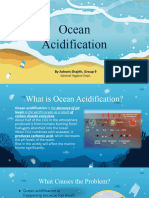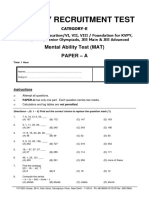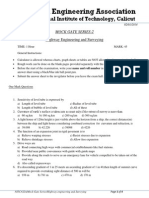0 ratings0% found this document useful (0 votes)
Ocean Acidification 1
Ocean Acidification 1
Uploaded by
Mansi BansodThis document summarizes a presentation on ocean acidification. It discusses how carbon dioxide absorbed by the ocean from human activities is increasing ocean acidity and impacting marine life. Specifically, it notes that higher acidity reduces available carbonate ions needed by shellfish and corals to build shells, and can alter behaviors of fish and seaweeds. While some algae may benefit from elevated CO2 levels, future ocean surface waters could reach a pH of around 7.8 by 2100 if emissions continue rising, threatening marine ecosystems and economies dependent on ocean resources. More monitoring is needed to fully understand acidification's effects on ocean food webs.
Copyright:
© All Rights Reserved
Available Formats
Download as PPTX, PDF, TXT or read online from Scribd
Download as pptx, pdf, or txt
Ocean Acidification 1
Ocean Acidification 1
Uploaded by
Mansi Bansod0 ratings0% found this document useful (0 votes)
This document summarizes a presentation on ocean acidification. It discusses how carbon dioxide absorbed by the ocean from human activities is increasing ocean acidity and impacting marine life. Specifically, it notes that higher acidity reduces available carbonate ions needed by shellfish and corals to build shells, and can alter behaviors of fish and seaweeds. While some algae may benefit from elevated CO2 levels, future ocean surface waters could reach a pH of around 7.8 by 2100 if emissions continue rising, threatening marine ecosystems and economies dependent on ocean resources. More monitoring is needed to fully understand acidification's effects on ocean food webs.
Copyright
© © All Rights Reserved
Available Formats
PPTX, PDF, TXT or read online from Scribd
Share this document
Did you find this document useful?
Is this content inappropriate?
This document summarizes a presentation on ocean acidification. It discusses how carbon dioxide absorbed by the ocean from human activities is increasing ocean acidity and impacting marine life. Specifically, it notes that higher acidity reduces available carbonate ions needed by shellfish and corals to build shells, and can alter behaviors of fish and seaweeds. While some algae may benefit from elevated CO2 levels, future ocean surface waters could reach a pH of around 7.8 by 2100 if emissions continue rising, threatening marine ecosystems and economies dependent on ocean resources. More monitoring is needed to fully understand acidification's effects on ocean food webs.
Copyright:
© All Rights Reserved
Available Formats
Download as PPTX, PDF, TXT or read online from Scribd
Download as pptx, pdf, or txt
0 ratings0% found this document useful (0 votes)
Ocean Acidification 1
Ocean Acidification 1
Uploaded by
Mansi BansodThis document summarizes a presentation on ocean acidification. It discusses how carbon dioxide absorbed by the ocean from human activities is increasing ocean acidity and impacting marine life. Specifically, it notes that higher acidity reduces available carbonate ions needed by shellfish and corals to build shells, and can alter behaviors of fish and seaweeds. While some algae may benefit from elevated CO2 levels, future ocean surface waters could reach a pH of around 7.8 by 2100 if emissions continue rising, threatening marine ecosystems and economies dependent on ocean resources. More monitoring is needed to fully understand acidification's effects on ocean food webs.
Copyright:
© All Rights Reserved
Available Formats
Download as PPTX, PDF, TXT or read online from Scribd
Download as pptx, pdf, or txt
You are on page 1/ 10
OCEAN ACIDIFICATION
Presented by :Mansi Bansod & Akansha Sharma
BALLB V
POINTS TO BE DISCUSSED
1.INTRODCTION
2.CARBON DIOXIDE AND SEAWATER
3.IMPACTS OF OCEAN ACIDIFICATION
ON SHELL BUILDERS
4.OCEAN ACIDIFICATION IMPACTS ON
FISH AND SEAWEEDS
5.OUR CHANGING OCEAN
6.CONCLUSION
20XX Presentation title 2
INTRODUCTION
1.In the 200-plus years since the industrial revolution
.
began, the concentration of carbon dioxide (CO2) in the
atmosphere has increased due to human actions.
2. During this time, the pH of surface ocean waters has
fallen by 0.1 pH units.
3. This change represents approximately a
30 percent increase in acidity.
4. The ocean absorbs about 30% of the carbon dioxide
(CO2) that is released in the atmosphere.
5. As levels of atmospheric CO2 increase from human
activity such as burning fossil fuels (e.g., car emissions)
and changing land use (e.g., deforestation), the amount of
3
carbon dioxide absorbed by the ocean also increases.
4
CARBON DIOXIDE AND SEAWATER
1.Carbon dioxide, which is naturally in the atmosphere, dissolves into seawater.
2. Water and carbon dioxide combine to form carbonic acid (H2CO3), a weak acid that breaks (or
“dissociates”) into hydrogen ions (H+) and bicarbonate ions (HCO3-).
3. The ocean’s average pH is now around 8.1 which is basic (or alkaline), but as the ocean continues
to absorb more CO2, the pH decreases and the ocean becomes more acidic.
20XX Presentation title 5
IMPACTS OF OCEAN ACIDIFICATION ON SHELL BUILDERS
1.Ocean acidification is already impacting many ocean species,
especially organisms like oysters and corals that make hard
shells and skeletons by combining calcium and carbonate from
seawater.
2.However, as ocean acidification increases, available carbonate
ions (CO32-) bond with excess hydrogen, resulting in fewer
carbonate ions available for calcifying organisms to build and
maintain their shells, skeletons, and other calcium carbonate
structures.
20XX Presentation title 6
OCEAN ACIDIFICATION
IMPACTS ON FISH AND
SEAWEEDS
1.Changes in ocean chemistry can affect the behavior of
non-calcifying organisms as well.
2. The ability of some fish, like clownfish, to detect
predators is decreased in more acidic waters.
3. When these organisms are at risk, the entire food web
may also be at risk.
4. While some species will be harmed by ocean
acidification, algae and seagrasses may benefit from
higher CO2 conditions in the ocean, as they require
CO2 for photosynthesis just like plants on land.
5. There are some ongoing studies examining if growing
seaweed can help slow ocean acidification.
20XX Presentation title 7
OUR CHANGING
OCEANS
1.Estimates of future carbon dioxide levels, based on business-
as-usual emission scenarios, indicate that by the end of this
century the surface waters of the ocean could have a
pH around 7.8
2.Ocean acidification is currently affecting the entire ocean,
including coastal estuaries and waterways. Billions of people
worldwide rely on food from the ocean as their
primary source of protein.
3.Many jobs and economies in the U.S. and around the world
depend on the fish and shellfish that live in the ocean.
20XX Presentation title 8
CONCLUSION
• Ocean acidification is one aspect of global
climate change. Anything we do to mitigate
climate change today will benefit the future of the
ocean as well.
• Over the last decade, there has been much focus
in the ocean science community on studying the
potential impacts of ocean acidification
• Because sustained efforts to monitor ocean
acidification worldwide are only beginning, it is
currently impossible to predict exactly how ocean
acidification impacts will cascade throughout
thethe food web and affect the overall structure of
marine ecosystems.
20XX Presentation title 9
THANK YOU.
20XX Presentation title 10
You might also like
- Sabiston Textbook of Surgery The Biological Basis of Modern Surgical Practice 21st Edition PDFNo ratings yetSabiston Textbook of Surgery The Biological Basis of Modern Surgical Practice 21st Edition PDF30 pages
- Ocean Acidification: Environmental Chemistry 1St Performance TaskNo ratings yetOcean Acidification: Environmental Chemistry 1St Performance Task20 pages
- NAME: Vinay ROLL No: EE-160 COURSE: Alternate Energy Assignment No.1 TOPIC: Demystifying Ocean Acidification and BiodiversityNo ratings yetNAME: Vinay ROLL No: EE-160 COURSE: Alternate Energy Assignment No.1 TOPIC: Demystifying Ocean Acidification and Biodiversity4 pages
- Ocean Acidification: Austin Marshall 4th Period 5-16-16No ratings yetOcean Acidification: Austin Marshall 4th Period 5-16-162 pages
- Ocean Acidification: Starting With The Science100% (2)Ocean Acidification: Starting With The Science20 pages
- A Special Introductory Guide For Policy Advisers and Decision MakersNo ratings yetA Special Introductory Guide For Policy Advisers and Decision Makers12 pages
- CO2 and Ocean Acidification - Union of Concerned ScientistsNo ratings yetCO2 and Ocean Acidification - Union of Concerned Scientists10 pages
- Ocean Acidification: A Hidden Risk For Sustainable DevelopmentNo ratings yetOcean Acidification: A Hidden Risk For Sustainable Development4 pages
- Title of The Research Climate Change andNo ratings yetTitle of The Research Climate Change and8 pages
- International Journal of Applied Sciences and Innovation - Vol 2015 - No 1 - Paper5No ratings yetInternational Journal of Applied Sciences and Innovation - Vol 2015 - No 1 - Paper54 pages
- The Impact of Ocean Acidification On Deep-Sea Coral EcosystemsNo ratings yetThe Impact of Ocean Acidification On Deep-Sea Coral Ecosystems3 pages
- effects_of_rising_seawater_temp_coral_reefsNo ratings yeteffects_of_rising_seawater_temp_coral_reefs33 pages
- Environmental Science Presentation Semester-2 (2020-21) Ramjas College, Delhi University Department of MathematicsNo ratings yetEnvironmental Science Presentation Semester-2 (2020-21) Ramjas College, Delhi University Department of Mathematics20 pages
- The Effects of Carbon Dioxide On Coral ReefsNo ratings yetThe Effects of Carbon Dioxide On Coral Reefs16 pages
- Ocean Acidification and Its Potential Effects On Marine EcosystemsNo ratings yetOcean Acidification and Its Potential Effects On Marine Ecosystems23 pages
- Eight Experiments On Ocean Acidification For School TeachingNo ratings yetEight Experiments On Ocean Acidification For School Teaching76 pages
- Sievers Certified Reference Materials and Consumables CatalogNo ratings yetSievers Certified Reference Materials and Consumables Catalog32 pages
- SDip - ME102 - Coord - 2015a - Rev - 25 - May - 2015 (ACMV)100% (1)SDip - ME102 - Coord - 2015a - Rev - 25 - May - 2015 (ACMV)37 pages
- SENTIMENT ANALYSIS of Incoming Calls On Help Desk New100% (1)SENTIMENT ANALYSIS of Incoming Calls On Help Desk New8 pages
- ENGLISH PRE AARAMBH CHECKLIST BY NIMISHA MAM 2 NOV 2023 DocxNo ratings yetENGLISH PRE AARAMBH CHECKLIST BY NIMISHA MAM 2 NOV 2023 Docx8 pages
- Wellbore Heat Loss in Production and Injection Wells, JPT Forum, 1979, 3 PGNo ratings yetWellbore Heat Loss in Production and Injection Wells, JPT Forum, 1979, 3 PG3 pages
- Fortinet Passguide Nse4 - fgt-70 Braindumps 2023-Jun-10 by Kennedy 83q VceNo ratings yetFortinet Passguide Nse4 - fgt-70 Braindumps 2023-Jun-10 by Kennedy 83q Vce21 pages
- Sabiston Textbook of Surgery The Biological Basis of Modern Surgical Practice 21st Edition PDFSabiston Textbook of Surgery The Biological Basis of Modern Surgical Practice 21st Edition PDF
- Ocean Acidification: Environmental Chemistry 1St Performance TaskOcean Acidification: Environmental Chemistry 1St Performance Task
- NAME: Vinay ROLL No: EE-160 COURSE: Alternate Energy Assignment No.1 TOPIC: Demystifying Ocean Acidification and BiodiversityNAME: Vinay ROLL No: EE-160 COURSE: Alternate Energy Assignment No.1 TOPIC: Demystifying Ocean Acidification and Biodiversity
- Ocean Acidification: Austin Marshall 4th Period 5-16-16Ocean Acidification: Austin Marshall 4th Period 5-16-16
- A Special Introductory Guide For Policy Advisers and Decision MakersA Special Introductory Guide For Policy Advisers and Decision Makers
- CO2 and Ocean Acidification - Union of Concerned ScientistsCO2 and Ocean Acidification - Union of Concerned Scientists
- Ocean Acidification: A Hidden Risk For Sustainable DevelopmentOcean Acidification: A Hidden Risk For Sustainable Development
- International Journal of Applied Sciences and Innovation - Vol 2015 - No 1 - Paper5International Journal of Applied Sciences and Innovation - Vol 2015 - No 1 - Paper5
- The Impact of Ocean Acidification On Deep-Sea Coral EcosystemsThe Impact of Ocean Acidification On Deep-Sea Coral Ecosystems
- Environmental Science Presentation Semester-2 (2020-21) Ramjas College, Delhi University Department of MathematicsEnvironmental Science Presentation Semester-2 (2020-21) Ramjas College, Delhi University Department of Mathematics
- Ocean Acidification and Its Potential Effects On Marine EcosystemsOcean Acidification and Its Potential Effects On Marine Ecosystems
- Eight Experiments On Ocean Acidification For School TeachingEight Experiments On Ocean Acidification For School Teaching
- Heated Waters: Tracing Environmental IntersectionsFrom EverandHeated Waters: Tracing Environmental Intersections
- Sievers Certified Reference Materials and Consumables CatalogSievers Certified Reference Materials and Consumables Catalog
- SDip - ME102 - Coord - 2015a - Rev - 25 - May - 2015 (ACMV)SDip - ME102 - Coord - 2015a - Rev - 25 - May - 2015 (ACMV)
- SENTIMENT ANALYSIS of Incoming Calls On Help Desk NewSENTIMENT ANALYSIS of Incoming Calls On Help Desk New
- ENGLISH PRE AARAMBH CHECKLIST BY NIMISHA MAM 2 NOV 2023 DocxENGLISH PRE AARAMBH CHECKLIST BY NIMISHA MAM 2 NOV 2023 Docx
- Wellbore Heat Loss in Production and Injection Wells, JPT Forum, 1979, 3 PGWellbore Heat Loss in Production and Injection Wells, JPT Forum, 1979, 3 PG
- Fortinet Passguide Nse4 - fgt-70 Braindumps 2023-Jun-10 by Kennedy 83q VceFortinet Passguide Nse4 - fgt-70 Braindumps 2023-Jun-10 by Kennedy 83q Vce

























































































